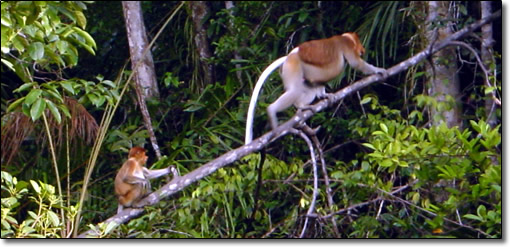
Bako National Park
Near Kuching is Bako National Park, one of the oldest in Sarawak, and one of the best places in Borneo to see Proboscis monkeys. Proboscis monkeys, endemic to Borneo, are simply unique. The males have large red noses, a long, thick white tail, red and gray “teddy-bear” fur, flattop “haircuts” and most importantly, giant pot bellies. They look like dressed up, beer-swilling burghers. Perhaps this is where their name in Malay, “Orang Belanda” (Dutch man) comes from. With their long legs covered in thick, gray fur, they appear to be wearing elegant trousers. The females are smaller, with small pig noses. The males, with their giant noses, make honking noises when aroused. Proboscis monkeys are generally shy. In Bako, they are accustomed to tourists, but still flee when confronted with noise or brusque movement. We got up every morning just after dawn to look for the monkeys. They could be seen in two nearby areas where forest bordered on tidal flats. In the morning the monkeys were sometimes still sleepy. Once we spied a male sitting in the crook of a tree, resting his head on his outstretched arms, sleeping. Another time, as we were walking quietly across the mud flats, looking in the trees, we heard a noise behind us. Among the mangroves were three otters watching us! They raised their heads, sniffing cautiously with their whiskered snouts before loping off. Evening time was better for primate observation. As the tide went out, proboscis monkeys would sometimes walk across the mud flats, looking for edible leaves in the mangroves. In the trees, the females with babies were the most elusive. At any disturbance they fled into the forest, a baby clutching their stomach, leaping between the trees.
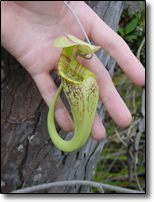 |
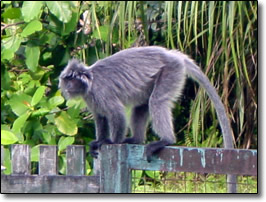 |
Hanging around park headquarters was a troop of long-tailed macaques. These pesky monkeys kept a keen eye out for open windows and doors. In a flash a brazen monkey would enter a room, looking for food, and ransack the contents. Even being near the monkeys was risky. The adolescents, playing in the grass, were under constant surveillance by the larger males. When their games became too rough, a baby would cry out in alarm. A male, coming over to investigate, would blame the tourist and approach menacingly, displaying his full set of teeth. Other scavengers, like the bearded pig, also hung around the park restaurant. If the pig came too close to their group, the macaques would chase it away. Apparently it had eaten one of the babies. Silver leaf monkeys (leaf-eating langurs) could also be seen in the camp vicinity. With long, silver-gray fur, beady eyes and a crest of hair on their head, these shy monkeys were often found in the nearby trees looking for food.
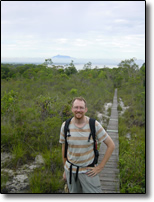 |
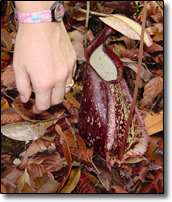 |
There were plenty of trails to explore around the park. One boardwalk trail passed through “kerangas”. An area of poor, sandy soil, kerangas is full of small, stunted trees and shrubs, like a high alpine environment. This is the best place to look for pitcher plants. Although found all over South-East Asia, the largest number of species is found in Borneo . At first, they were hard to spot. But after finding one, we started to see them everywhere! The “pitcher” is an adaptation to capture and digest insects in order to supplement the lack of soil nutrients. From leaf of the plant, a long stem grows into an elongated, upright vessel with a small lid to keep out rain. Some plants are found on the ground, while others climb like creepers, displaying their pitchers amongst the surrounding trees and bushes. One trail took us down to a deserted beach, but not before crossing through a thick, muddy mangrove forest and picking our way over a twisted mass of exposed roots.
